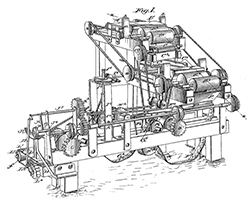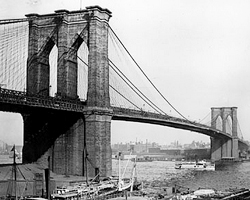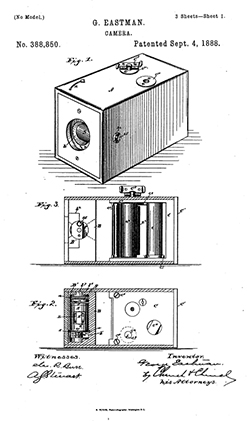MENU
The Electronic Scholarly Publishing Project: Providing access to classic scientific papers and other scholarly materials, since 1993. More About: ESP | OUR CONTENT | THIS WEBSITE | WHAT'S NEW | WHAT'S HOT
Comparative Timelines
The ESP Timeline (one of the site's most popular features) has been completely updated to allow the user to select (using the timeline controls above each column) different topics for the left and right sides of the display.
Select:
New Left Column
New Left Column
Dates
Decade
New Right Column
New Right Column
 James Albert Bonsack invents the first automated cigarette-rolling machine after seeing a tobacco company offer a prize for the first machine to roll and cut a cigarette. The Bonsack machine could roll up to 210 cigarettes per minute, compared to the average of four cigarettes per minute that could be rolled by hand. The Bonsack machine revolutionized the cigarette industry by making it possible to mass-produce inexpensive cigarettes.
James Albert Bonsack invents the first automated cigarette-rolling machine after seeing a tobacco company offer a prize for the first machine to roll and cut a cigarette. The Bonsack machine could roll up to 210 cigarettes per minute, compared to the average of four cigarettes per minute that could be rolled by hand. The Bonsack machine revolutionized the cigarette industry by making it possible to mass-produce inexpensive cigarettes.
1880
(no entry for this year)
 James A Garfield becomes twentieth president of the United States.
James A Garfield becomes twentieth president of the United States.
Six months after taking office, Garfield becomes the second US President to be assassinated, when he was shot by Charles J. Guiteau — a disgruntled and impoverished would-be office holder. When he purchased the pistol used in the assassination, he chose to buy one with an ivory handle because he thought it would look good as a museum exhibit after the assassination.
In January, the Tennessee State Legislature votes to segregate railroad passenger cars.
 On the Fourth of July, Booker T. Washington opens Tuskegee Institute in central Alabama.
On the Fourth of July, Booker T. Washington opens Tuskegee Institute in central Alabama.
 Chester A. Arthur becomes twenty-first president of the United States.
Chester A. Arthur becomes twenty-first president of the United States.
 Clara Barton founds the American Red Cross.
Clara Barton founds the American Red Cross.
1881
(no entry for this year)
The first hydro-electric plant opens, in Wisconsin.
Britain Invades Egypt The British invaded Egypt in response to anti foreign riots. The British defeated the army of Arabi Pasha at Al Tell. On September 15th they captured Cairo. Arabi pasha the nationalist leader was deported to Ceylon.
1882
(no entry for this year)
On October 16, the United States Supreme Court declares invalid the Civil Rights Act of 1875, stating that the federal government cannot bar corporations or individuals from discriminating on the basis of race.
Scheutz invents the first printing calculator
 German engineer Gottlieb Daimler creates a portable engine that leads to the age of the automobile.
German engineer Gottlieb Daimler creates a portable engine that leads to the age of the automobile.
 On May 25, the New York boroughs of Manhattan and Brooklyn were linked with the opening of the Brooklyn Bridge. The bridge was the first steel suspension bridge erected in the United States. It was built at a cost of $16 million and 26 lives. When it opened, the Brooklyn Bridge was the longest suspension bridge in the world.
On May 25, the New York boroughs of Manhattan and Brooklyn were linked with the opening of the Brooklyn Bridge. The bridge was the first steel suspension bridge erected in the United States. It was built at a cost of $16 million and 26 lives. When it opened, the Brooklyn Bridge was the longest suspension bridge in the world.
1883
(no entry for this year)
 James Dewar invents a thermos bottle in which heat is prevented from leaking via vacuum between two glass walls. The model becomes known as the Dewar Flask.
James Dewar invents a thermos bottle in which heat is prevented from leaking via vacuum between two glass walls. The model becomes known as the Dewar Flask.
 The world's first skyscraper, the Home Insurance Company Building, is erected in Chicago.
The world's first skyscraper, the Home Insurance Company Building, is erected in Chicago.
 Grover Cleveland becomes twenty-second president of the United States.
Grover Cleveland becomes twenty-second president of the United States.
1885
(no entry for this year)
Slavery is abolished in Cuba.
Daimler produces his first car.
1886
(no entry for this year)
African-American players are banned from major league baseball.
Slavery is abolished in Brazil
Dorr E. Felt was granted a patent for the Comptometer.
Introduction of the Comptometer by Felt & Tarrant Co
Celluloid film base introduced.
Interstate Commerce Act Passed On February 4, President Cleveland signed into law the first bill regulating the railroads. The act, which called for just and equal rates, also limited pooling (secret pacts between railroads). This measure received broad support in the Congress.
The United States acquires Pearl Harbor, Hawaii, as a coaling station and future naval base.
1887
(no entry for this year)
Babbage's Analytical Engine Operates For The First Time
Burroughs Receives Patent for Calculating Machine
Introduction of its adder-lister by William Seward Burroughs
 Eastman patents Kodak roll-film camera.
Eastman patents Kodak roll-film camera.
Louis Le Prince makes Roundhay Garden Scene. It is believed to be the first-ever motion picture on film.
 John Boyd Dunlop, trained as a veterinary surgeon, devises the first practical pneumatic tire in response to a request from his son for a more comfortable tricycle. His first effort involved an inflated section of garden hose, fitted to the rear wheels of the tricycle. Although born in Scotland, Dunlop spent most of his life in Northern Ireland, where his image occurs on the current £10 note, issued by the Northern Bank.
John Boyd Dunlop, trained as a veterinary surgeon, devises the first practical pneumatic tire in response to a request from his son for a more comfortable tricycle. His first effort involved an inflated section of garden hose, fitted to the rear wheels of the tricycle. Although born in Scotland, Dunlop spent most of his life in Northern Ireland, where his image occurs on the current £10 note, issued by the Northern Bank.
 George Eastman Patents Camera George Eastman patents the hand held camera.
George Eastman Patents Camera George Eastman patents the hand held camera.
Slavery is abolished in Brazil, bringing to an end of the legal sanction of slavery in the Americas.
1888
(no entry for this year)
Florida becomes the first state to use the poll tax to disenfranchise black voters.
 Frederick Douglass is appointed minister to Haiti.
Frederick Douglass is appointed minister to Haiti.
Nintendo is founded as Nintendo Koppai on 23 September 1889 by craftsman Fusajiro Yamauchi in Shimogyo-ku, Kyoto, Japan, as an unincorporated establishment, to produce and distribute Japanese playing cards, or karuta (from Portuguese carta, 'card'), most notably hanafuda ('flower cards').
Herman Hollerith lodges patent for Punch Card technology
The first commercially available transparent celluloid roll film is introduced by the Eastman Company, later renamed the Eastman Kodak Company and commonly known as Kodak.
 Benjamin Harrison becomes twenty-third president of the United States.
Benjamin Harrison becomes twenty-third president of the United States.
Oklahoma Land Rush The last major unsettled territory in the United States (which had been exclusively Indian) is opened for settlement. Over 200,000 settlers gather at the borders of the territory awaiting the opportunity to seize land. On the first day the territory was opened, 12,000 settlers arrived in Guthrie, Oklahoma.
1889
(no entry for this year)
ESP Quick Facts
ESP Origins
In the early 1990's, Robert Robbins was a faculty member at Johns Hopkins, where he directed the informatics core of GDB — the human gene-mapping database of the international human genome project. To share papers with colleagues around the world, he set up a small paper-sharing section on his personal web page. This small project evolved into The Electronic Scholarly Publishing Project.
ESP Support
In 1995, Robbins became the VP/IT of the Fred Hutchinson Cancer Research Center in Seattle, WA. Soon after arriving in Seattle, Robbins secured funding, through the ELSI component of the US Human Genome Project, to create the original ESP.ORG web site, with the formal goal of providing free, world-wide access to the literature of classical genetics.
ESP Rationale
Although the methods of molecular biology can seem almost magical to the uninitiated, the original techniques of classical genetics are readily appreciated by one and all: cross individuals that differ in some inherited trait, collect all of the progeny, score their attributes, and propose mechanisms to explain the patterns of inheritance observed.
ESP Goal
In reading the early works of classical genetics, one is drawn, almost inexorably, into ever more complex models, until molecular explanations begin to seem both necessary and natural. At that point, the tools for understanding genome research are at hand. Assisting readers reach this point was the original goal of The Electronic Scholarly Publishing Project.
ESP Usage
Usage of the site grew rapidly and has remained high. Faculty began to use the site for their assigned readings. Other on-line publishers, ranging from The New York Times to Nature referenced ESP materials in their own publications. Nobel laureates (e.g., Joshua Lederberg) regularly used the site and even wrote to suggest changes and improvements.
ESP Content
When the site began, no journals were making their early content available in digital format. As a result, ESP was obliged to digitize classic literature before it could be made available. For many important papers — such as Mendel's original paper or the first genetic map — ESP had to produce entirely new typeset versions of the works, if they were to be available in a high-quality format.
ESP Help
Early support from the DOE component of the Human Genome Project was critically important for getting the ESP project on a firm foundation. Since that funding ended (nearly 20 years ago), the project has been operated as a purely volunteer effort. Anyone wishing to assist in these efforts should send an email to Robbins.
ESP Plans
With the development of methods for adding typeset side notes to PDF files, the ESP project now plans to add annotated versions of some classical papers to its holdings. We also plan to add new reference and pedagogical material. We have already started providing regularly updated, comprehensive bibliographies to the ESP.ORG site.
ESP Picks from Around the Web (updated 06 MAR 2017 )
Old Science

Weird Science

Treating Disease with Fecal Transplantation
Fossils of miniature humans (hobbits) discovered in Indonesia

Dinosaur tail, complete with feathers, found preserved in amber.
Astronomy

Mysterious fast radio burst (FRB) detected in the distant universe.